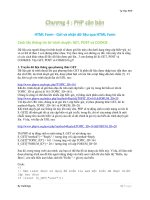lập trình web php. truyền và nhận dữ liệu - gv trần đình nghĩa
Bạn đang xem bản rút gọn của tài liệu. Xem và tải ngay bản đầy đủ của tài liệu tại đây (3.39 MB, 32 trang )
THIẾT KẾ VÀ LẬP TRÌNH WEB
1
Lập Trình Web
PHP – Truyền và Nhận dữ liệu
ĐẠI HỌC SÀI GÒN – KHOA CNTT
GV: Trần Đình Nghĩa
THIẾT KẾ VÀ LẬP TRÌNH WEB
2
Nội dung
1.Cơ chế truyền nhận dữ liệu.
2.Truyền nhận qua phương thức GET
3.Truyền nhận qua phương thức
POST
4.Một số ví dụ
5.Thực hành
THIẾT KẾ VÀ LẬP TRÌNH WEB
3
Cơ chế truyền nhận dữ liệu
Web browser (client) gởi dữ liệu đến website
thông qua các HTML Control (Form Field).
Internet /
Intranet
Databas
e
Server
Disk
Driver
Apache / IIS
Server-side-script
Parser (PHP,
ASP,…)
Web Browser
Webserver
www.example.com
THIẾT KẾ VÀ LẬP TRÌNH WEB
4
Cơ chế truyền nhận dữ liệu
Web server nhận và xử lý dữ liệu và trả kết
quả cho client.
Internet /
Intranet
Web Browser
Webserver
www.example.com
Yêu cầu trang b.php
THIẾT KẾ VÀ LẬP TRÌNH WEB
5
Cơ chế truyền nhận dữ liệu
Internet /
Intranet
Web Browser
Webserver
www.example.com
Yêu cầu trang b.php
THIẾT KẾ VÀ LẬP TRÌNH WEB
6
Cơ chế truyền nhận dữ liệu
Internet /
Intranet
Web Browser
Webserver
www.example.com
THIẾT KẾ VÀ LẬP TRÌNH WEB
7
Cơ chế truyền nhận dữ liệu
Internet /
Intranet
Web Browser
Webserver
www.example.com
THIẾT KẾ VÀ LẬP TRÌNH WEB
8
Cơ chế truyền nhận dữ liệu
THIẾT KẾ VÀ LẬP TRÌNH WEB
9
Cơ chế truyền nhận dữ liệu
Internet /
Intranet
Web Browser
Webserver
www.example.com
THIẾT KẾ VÀ LẬP TRÌNH WEB
10
Cơ chế truyền nhận dữ liệu
Internet /
Intranet
Web Browser
Webserver
www.example.com
Yêu cầu trang xuly.php
Textbox: txtUsername = admin
Password Box: txtPassword = phpadmin
THIẾT KẾ VÀ LẬP TRÌNH WEB
11
Cơ chế truyền nhận dữ liệu
Internet /
Intranet
Web Browser
Webserver
www.example.com
Yêu cầu trang xuly.php
txtUsername = admin
txtPassword = phpadmin
THIẾT KẾ VÀ LẬP TRÌNH WEB
12
Cơ chế truyền nhận dữ liệu
Internet /
Intranet
Web Browser
Webserver
www.example.com
Yêu cầu trang xuly.php
txtUsername = admin
txtPassword = phpadmin
THIẾT KẾ VÀ LẬP TRÌNH WEB
13
Cơ chế truyền nhận dữ liệu
Internet /
Intranet
txtUsername = admin
txtPassword = phpadmin
THIẾT KẾ VÀ LẬP TRÌNH WEB
14
Cơ chế truyền nhận dữ liệu
Trang web nhập dữ liệu
Sử dụng đối tượng <form>
Nhập liệu thông qua các formfield
Thực hiện việc truyền dữ liệu qua Submit
<form action=“xuly.php" method ="post">
Username: <input type="text" name=“txtname"/>
Password: <input type="text" name=“password"/>
<input type ="submit">
</form>
THIẾT KẾ VÀ LẬP TRÌNH WEB
15
Cơ chế truyền nhận dữ liệu
Trang web nhận dữ liệu (URL): Sử dụng các
biến toàn cục của PHP
–$_POST[“FieldName”]
–$_GET[“FieldName”]
–$_REQUEST[“FieldName”]
THIẾT KẾ VÀ LẬP TRÌNH WEB
16
xltimSach.php
Cơ chế truyền nhận dữ liệu
THIẾT KẾ VÀ LẬP TRÌNH WEB
17
Cơ chế truyền nhận dữ liệu
THIẾT KẾ VÀ LẬP TRÌNH WEB
18
Ví dụ: xuly.php
THIẾT KẾ VÀ LẬP TRÌNH WEB
19
Tham số truyền đi qua địa chỉ URL
http://domain/pathfile?fieldname1=value1&
fieldname2=value2
http://localhost/xuly.php?txtTukhoa=“Tri%2
0tue”
Nhận dữ liệu thông qua các biến toàn cục
$_GET[“FieldName”]
$_REQUEST[“FieldName”]
Phương thức GET
THIẾT KẾ VÀ LẬP TRÌNH WEB
20
Ưu điểm:
Có thể bookmark địa chỉ URL
Có thể giả lập truyền nhận dữ liệu mà không
thông qua Form
Khuyết điểm:
Không có tính bảo mật
Dung lượng giới hạn
URL submit được lưu lại trên Server
Phương thức GET
THIẾT KẾ VÀ LẬP TRÌNH WEB
21
Tham số truyền ẩn bên trong
Nhận dữ liệu thông qua các biến toàn
cục
$_POST[“FieldName”]
$_REQUEST[“FieldName”]
Phương thức POST
THIẾT KẾ VÀ LẬP TRÌNH WEB
22
Ưu điểm:
Bảo mật
Không giới hạn dung lượng truyền dữ liệu
Khuyết điểm:
Trang web trả về không thể bookmark
Có thể bị lỗi khi Back hoặc Refresh
(expired)
Security gây khó khăn cho vấn đề truyền dữ
liệu
Phương thức POST
THIẾT KẾ VÀ LẬP TRÌNH WEB
23
Một số ví dụ
THIẾT KẾ VÀ LẬP TRÌNH WEB
24
Một số ví dụ
THIẾT KẾ VÀ LẬP TRÌNH WEB
25
Một số ví dụ









